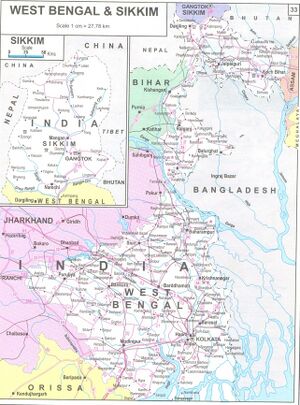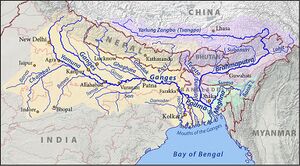West Bengal

West Bengal (पश्चिम बंगाल) is a state in eastern India. The state capital is Kolkata.
Variants
- Bengal बंगाल (AS, p.599)
- Harakela हरकेल, बंगाल या पूर्वी बंगाल, (AS, p.1007)
- Harikela हरिकेल = Harakela हरकेल (p.1009)
Location
It is bordered by the countries of Bangladesh, Nepal and Bhutan, and the Indian states of Odisha, Jharkhand, Bihar, Sikkim, and Assam.
Origin of name
The word Bengal derives from "Banga", a Dravidian tribe that settled the region around 1000 BC.[1] The word might have been derived from the ancient kingdom of Vanga (or Banga).
History
The region was a part of the Vanga Kingdom according to the Indian epic Mahabharata.[2]
Bhima was sent out to the East, since Bhishma thought the easterners were skilled in fighting from the backs of elephants and in fighting with bare arms, he deemed Bhima to be the most ideal person to wage wars in that region. The Mahabharata mentions several kingdoms to the east of Indraprastha which were conquered by Bhima. According to Sabha Parva, Mahabharata/Book II Chapter 26 & Sabha Parva, Mahabharata/Book II Chapter 27 Bhimasena subjugated the countries including: Vanga (वङ्ग).[3]
Several Vedic realms were present in Bengal region, including Vanga, Rarh, Pundravardhana and the Suhma Kingdom.
One of the earliest foreign references to Bengal is a mention by the Ancient Greeks around 100 BC of a land named Gangaridai, which was located at the mouths of the Ganges.[4]
Bengal had overseas trade relations with Suvarnabhumi (Burma, Lower Thailand, Lower Malay Peninsula, and the Sumatra).[5]
According to the Sri Lankan chronicle Mahavamsa, Prince Vijaya, a Vanga Kingdom prince, conquered Lanka (modern day Sri Lanka) and gave the name Sinhala Kingdom to the country.[6]
The kingdom of Magadha was formed in 7th century BCE, consisting of the regions now comprising Bihar and Bengal. It was one of the four main kingdoms of India at the time of the lives of Mahavira, founder of Jainism, and Gautama Buddha, founder of Buddhism, and consisted of several janapadas or kingdoms.[7]
Under Ashoka, the Maurya Empire of Magadha extended over nearly all of South Asia, including Afghanistan and parts of Balochistan in the 3rd century BCE.[8]
From the 3rd to the 6th centuries CE, the kingdom of Magadha served as the seat of the Gupta Empire.
Two kingdoms – Vanga or Samatata and Gauda – are mentioned in some texts to have appeared after the end of Gupta Empire, although details of their ruling time are uncertain.[9]
The first recorded independent king of Bengal was Shashanka who reigned in the early 7th century.[10] After a period of anarchy, the Buddhist Pala dynasty ruled the region for four hundred years starting from the eighth century, followed by a shorter reign of the Hindu Sena dynasty. Some areas of Bengal were invaded by Rajendra Chola I of the Chola dynasty between 1021 and 1023.[11]
Islam made its first appearance in Bengal during the 12th century when Sufi missionaries arrived.[12]
Later, occasional Muslim raiders reinforced the process of conversion by building mosques, madrasas and khanqahs. Between 1202 and 1206, Muhammad bin Bakhtiyar Khilji, a military commander from the Delhi Sultanate, overran Bihar and Bengal as far east as Rangpur, Bogra and the Brahmaputra River. Although he failed to bring Bengal under his control, the expedition managed to defeat Lakshman Sen and his two sons moved to a place then called Vikramapur (present-day Munshiganj District), where their diminished dominion lasted until the late 13th century.
Subsequent Muslim conquests helped spread Islam throughout the region.[13] Consequently, the region was ruled by dynasties of Bengal Sultanate and feudal lords under the Delhi Sultanate for the next few hundred years.
Smaller Hindu states, landlords and Baro-Bhuyans also ruled in parts of Bengal. The Bengal Sultanate was interrupted for 20 years by an uprising by the Hindus under Raja Ganesha. In the sixteenth century, Mughal general Islam Khan conquered Bengal. However, administration by governors appointed by the court of the Mughal Empire gave way to semi-independence of the area under the Nawabs of Murshidabad, who nominally respected the sovereignty of the Mughals in Delhi. There were several independent Hindu states established in Bengal during the Mughal period like those of Pratapaditya of Jessore District and Raja Sitaram Ray of Bardhaman. The Koch dynasty in northern Bengal flourished during the period of 16th and the 17th centuries as well as weathered the Mughals and survived till the advent of the British.
बंगाल

विजयेन्द्र कुमार माथुर[14] ने लेख किया है .....बंगाल (AS, p.599): किंवदंती में इस देश के नामकरण का आधार इस प्रकार बताया जाता है कि [p.600]: प्राचीन काल में पद्मा नदी के दक्षिण में स्थित और हुगली नदी और गंगा की दूसरी शाखा मधुमति के बीच के भाग को बंग या बंगा कहते थे क्योंकि यह भूभाग राजा बलि के पुत्र बंग के अधिकार में था. हुगली के ठीक पश्चिम के प्रदेश को लाहा कहा जाता था. कुछ काल पश्चात् इन्हीं दोनों भागों बंगा लाहा का नाम बंगाल हो गया (देखें बंग)
वंग = बंग
विजयेन्द्र कुमार माथुर[15] ने लेख किया है .....वंग (AS, p.827) या 'बंग' बंगाल का प्राचीन नाम है। महाभारत में वंग नरेश पर पाण्डव भीम की चढ़ाई का उल्लेख है- 'उभौ बलभृतौ वीराबुभौतीव्रपराक्रमौ निजित्याजौ महाराज बंगराजमुपाद्रवत।'महाभारत, सभापर्व 30, 23. बंग निवासियों के युधिष्ठिर के राजसूय यज्ञ में कलिंग और मगध के लोगों के साथ आगमन का वर्णन महाभारत सभापर्व 52, 18 में इस प्रकार है- 'वंगाः कलिंगा मगधास्ताम्रलिप्ताः संपुड्रकाः दौवालिका: सागरकाः पत्रौर्णाः शैशवास्तथा।'
कालिदास ने रघु की दिग्विजय यात्रा के दौरान वंग निवासियों का युद्ध में परास्त होने का वर्णन किया है- 'वंगा नुत्खाव तरसा नेता नौसाधनोद्यतान् निचखान जयस्तंभान्गंगास्त्रोतोन्तरेषु सः।' अर्थात "रघु ने अनेक नौकाओं के साधन से संपन्न बंग निवासियों को बलात् विस्थापित करके गंगा के स्त्रोतो के बीच विजय स्तंभ गढ़वाये।"
महरौली के लौह स्तंभ पर 'चंद्र' नामक नरेश के अभिलेख में उसकी विजय का विस्तार बंग देश तक बताया गया है- 'स्योद्वर्तयत: प्रतीपमुरसा शत्रून् सवेत्यागतान, वंगेष्वाहववर्तिनोस भिलिखिता खड्गेनकीर्तिर्भजे...।' (नई खोजो के अनुसार इस अभिलेख का वंग शायद सिंध देश का एक भाग था।) प्राचीन काल में बंग सामान्य रूप से पूरे बंगाल का नाम था, किंतु कभी-कभी यह शब्द केवल पूर्वी बंगाल के लिए ही प्रयोग होता था।
'माधवचंचू' में बंग और गौड़ भिन्न प्रदेश माने गए हैं। सुह्य पश्चिमी-दक्षिणी बंगाल (राजधानी ताम्रलिप्ति) और समतट 'बंगाल की खाड़ी' के तटवर्ती प्रदेश का नाम था। 'राढ़' या 'राढ़ी' भी बंगाल का एक भाग ( बर्दवान कमिश्नरी) था।
'पुंड्र' गंगा की मुख्य धारा (ब्रह्मपुत्र-गंगा की संयुक्त धारा) के उत्तर में स्थित प्रदेश का नाम था। डाउसन (देखें क्लासिकल डिक्शनरी) के अनुसार प्राचीन काल में बंग भागीरथी के उत्तर में स्थित भाग का नाम था, जिसमें जैसोर और कृष्णनगर के ज़िले सम्मिलित थे। जैन साहित्य में बंग का कई स्थानों पर उल्लेख है। 'प्रज्ञापणा सूत्र' में बंग को अंग के साथ ही आर्यजनों का श्रेष्ठ स्थान बताया गया है।
हरकेल
हरकेल (AS, p.1007): बंगाल या पूर्वी बंगाल (देखें हेमचंद्र, अभिधान चिंतामणि)[16]
Districts
The districts that are located at the north of the Ganges— often referred to collectively as North Bengal.
The districts on the south of the Ganges—
- Bankura,
- Bardhaman,
- Birbhum,
- Purulia,
- Murshidabad,
- Nadia,
- West Midnapore,
- East Midnapore,
- Hooghly,
- Howrah,
- Kolkata,
- North 24 Parganas and
- South 24 Parganas
These constitute a variety of geographical regions such as the Rarh region, the Western plateau and high lands, the coastal plains, the Sunderbans and the Ganges Delta.
Kolkata, the capital of the state, constitutes the Kolkata district.
Topics of historical importance
- Ajay River
- Atrai River
- Bakreshwar (Birbhum)
- Bankura
- Barabhum
- Bardhaman
- Barrackpore
- Birbhum
- Bishnupur
- Chandravarman
- Deokot
- Dhalbhum
- Dhalkisor or Dwarakeswar River
- Gauda
- Hura
- Katwa Bardhman
- Khatra Bankura
- Kotivarsha
- Kuch Bihar
- Malda
- Mallabhum
- Mangalkot
- Manbazar (Purulia)
- Manbhum (Purulia)
- Mayurakshi River/Mor River
- Midnapore
- Murshidabad
- Nadia
- Navanagara/Navadvipa
- Pakhanna
- Pala Empire
- Pandu Rajar Dhibi
- Purulia
- Raniganj
- Rarh region
- Suri Birbhum
- Susunia
- Tamralipti
- Tamluk
External links
See also
References
- ↑ "Bangladesh: early history, 1000 B.C.–A.D. 1202"
- ↑ Sen, S. N. (1999). Ancient Indian History And Civilization. New Age International. pp. 273–274. ISBN 978-81-224-1198-0.
- ↑ उभौ बलवृतौ वीराव उभौ तीव्रपराक्रमौ, निर्जित्याजौ महाराज वङ्ग राजम उपाथ्रवत (II.27.21) समुद्रसेनं निर्जित्य चन्द्रसेनं च पार्दिवम, ताम्रलिप्तं च राजानं काचं वङ्गाधिपं तदा (II.27.22)
- ↑ Chakrabarti, Dilip K. (2001). Archaeological Geography of the Ganga Plain: The Lower and the Middle Ganga. Delhi: Permanent Black. pp. 154–155. ISBN 81-7824-016-5.
- ↑ Prasad, Prakash Chandra (2003). Foreign trade and commerce in ancient India. New Delhi: Abhinav Publications. p. 28. ISBN 978-81-7017-053-2.
- ↑ Geiger, Wilhelm (2003) [1908]. "Chapter VI: The Coming of Viajaya". Mahavamsa: Great Chronicle of Ceylon. New Delhi: Asian Educational Services. pp. 51–54. ISBN 81-206-0218-8.
- ↑ Sultana, Sabiha. "Settlement in Bengal (Early Period)". Banglapedia. Asiatic Society of Bangladesh
- ↑ "The Truth of Babri Mosque"
- ↑ Sen, S. N. (1999). Ancient Indian History And Civilization. New Age International. pp. 273–274. ISBN 978-81-224-1198-0.
- ↑ "Shashanka". Banglapedia. Asiatic Society of Bangladesh.
- ↑ Sengupta, Nitish K. (2011). Land of two rivers: a history of Bengal from the Mahabharata to Mujib. Penguin Books India. p. 45. ISBN 978-0-14-341678-4.
- ↑ Banu, U. A. B. Razia Akter (January 1992). Islam in Bangladesh. BRILL. pp. 2, 17. ISBN 978-90-04-09497-
- ↑ "Islam (in Bengal)". Banglapedia. Asiatic Society of Bangladesh.
- ↑ Aitihasik Sthanavali by Vijayendra Kumar Mathur, p.599
- ↑ Aitihasik Sthanavali by Vijayendra Kumar Mathur, p.827
- ↑ Aitihasik Sthanavali by Vijayendra Kumar Mathur, p.1007

